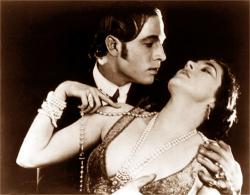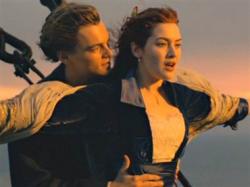Article
Great Romances
Written by Patrick
First Posted: July 29th, 2001

Rudolph Valentino and Nita Naldi in Blood and Sand.
The following movies reflect my own personal taste and experience. I have created a list of the greatest screen romances. The list is chronological in order. Ten movies which represent every era of feature-length Hollywood moviemaking in the 20th century, and though some of them are not in the traditional love-story mode, they all have archetypal characters dripping with on-screen chemistry. This is my argument...
My choice for the greatest early screen romance is Blood and Sand. This 1922 silent movie stars Rudolph Valentino as the tragic toreador Juan, a rather hapless young man in love with two women. One of them his pure and all-forgiving wife, the other the rich and mysterious Dona Sol, daughter of a Marquis. The setting is a picture perfect Seville and the swarthy and radiant Valentino has great close-ups as well as several exciting bullfighting sequences. Famed silent actress Nita Naldi is second billed as the other woman, yet it is with her that the sparks fly. She hams it up beautifully acting like a young Norma Desmond throughout. Throw in plenty of old-fashioned foreshadowing and symbolism, ranging from overtly obvious symbolism involving a ring to somewhat more subtle symbolism in the ironic parallels between Juan’s life and the life of a famous bandit named Plumitas. The tragic ending is simply icing on a very decadent cake.
Fast forward to 1927, boy what a difference five years can make. Lindbergh had flown the Atlantic, the Babe had set his homerun record, The Great Gatsby was in book stores, Dixieland was the music of choice of the younger generation and NBC was in place as the first nation-wide radio station. Movies were about to learn to talk and the stock market crash loomed just around the corner when It was released at the absolute height of the jazz age; and starring eternal flapper Clara Bow as a salesgirl in a Manhattan department store in love with her playboy boss, played by Antonio Moreno. This movie displayed a contemporary society undergoing drastic changes. Clara Bow’s Betty Lou is every inch the modern independent woman yearning for love and a better standard of living. In a daring plot twist for its time It deals with the taboo of unwed motherhood. The material is handled well without being preachy or taking sides. Thanks mostly to columnist Elinor Glyn for writing the screen play; she also appears in a cameo and actually coined the term IT as a way of describing people with sex appeal. A very young Gary Cooper has a bit part as a journalist. The famous climactic yacht scene is not only wonderful but has influenced, at least to some degree, moments in movies like It Happened One Night and Overboard; and unlike Blood and Sand, this one has a happy ending.
By 1934 the American public had endured nearly five years of the worst depression in modern times. How fortunate that one of the greatest screen romances ever appeared in the guise of a fast-paced, fast talking, screwball comedy called It Happened One Night. Clark Gable and Claudette Colbert sparkle in this hugely successful movie for which they, as well as director Frank Capra, received Oscars. Gable as journalist Peter Warne and Colbert as spoiled heiress-on-the-run Ellie Andrews run absolutely amok, wreaking havoc and laughs galore all the while creating sparks of anticipation with their so-called “Walls of Jericho”. These two have more chemistry than should be legal. This road romance is full of interesting characters behaving outrageously and it perfectly captures a time era long gone. Legend has it that the sales of men’s undershirts plummeted in the United States after Gable undressed in this movie and was clearly not wearing one. The hitchhiking scene is quite simply a peak moment in cinema history.
At the end of the decade economically the country was on the upswing, yet the growing clouds of war hung heavy on Europe and brought worry to those in the know. It was also the peak year of the old Hollywood studio system. 1939 produced more great Hollywood movies than any other year; Stagecoach, Wuthering Heights, Mr. Smith goes to Washington, Dark Victory, Destry Rides Again, Gunga Din and Ninotchka; oh yeah, and two little movies you may have heard of called The Wizard of Oz and Gone with the Wind. This last movie is the next on my list. What’s appealing about Scarlett O’Hara and Rhett Butler is that they are, quite possibly, the two least sympathetic lovers ever to grace the screen (at least in the pre-Bonnie & Clyde era). Only during the last act are we given any reason to feel compassion for them as people. After all he is a womanizing, gambling drinker, the black sheep of his wealthy Charleston family, a man who only looks out for himself; likewise she is a self-centered, manipulative bitch. The brilliance of Gone With the Wind is in the way it weaves their passionately doomed relationship into the fabric of the epic setting. It would be nearly sixty years before another tragic love story of equal grandeur was successfully made. That being the 1997 movie Titanic.
The climax of the twentieth century occurred between the attack on Pearl Harbor and the dropping of the bomb at Hiroshima. How fitting that the greatest movie romance ever was produced between these two events. Casablanca is celluloid magic from beginning to end. The perfect blend of intrigue and romance featuring the best known dialogue in movies. No matter how many times I watch it I never fail to get choked up whenever Bogie launches into his “hill of beans” speech. Cynical posturing be damned, his Rick is a hopeless romantic, sacrificing his one true love for a higher cause. Ingrid Bergman is positively iridescent as Ilsa caught between her activist husband and the great passion of her life, Rick. This love story will live forever. Like the song says, “You must remember this...”
The American Film Institute recently ranked Humphrey Bogart and Katharine Hepburn as the top male and female movie stars of all time. The only movie they ever made together is the next great romance on my list. When The African Queen was released in 1951the Hollywood studio system was just beginning to feel the threat of television. Hollywood had to offer something that TV didn’t; namely wide-screen movies shot in Technicolor. Filming on location was also becoming a common way to entice people off their couches. The African Queen is shot almost entirely in Africa. This is the greatest adventure romance, telling the story of a spinster missionary who travels through the heart of Kenya with a grisly, drunken boat runner. Of course they fall in love amidst the leeches and crocodiles and, this being WWI, even manage to sink a German boat, The Louisa. Katie and Bogie are indeed perfect together.
By 1967 when the next movie on my list was released, the world had undergone many major changes. The youth cult of rock and roll had exploded into a vast cultural movement the likes of which had never been seen. The movies were just beginning to reflect this change. Sex, graphic violence and profane language were soon to be a normal part of the movie-going experience. Bonnie & Clyde though set in the early thirties was very groundbreaking at the time. The climactic shots of their dancing bodies riddled with bullets is still a powerful scene today. Though a far cry from being a traditional love story, Warren Beatty and Faye Dunaway sizzle; to quote my brother Eric “From their first meeting to their last car ride, these two are concupiscent together”. I quite agree.
The year 1973 brought two of the silver screen’s most dynamic and charismatic young stars together in The Way We Were. Streisand & Redford as Katie Morosky and Hubbell Gardener. He the perfect all-American golden boy and she the essence of the Jewish political-activist outsider. Their story, spanning from their campus days in the late thirties through their final heartbreaking meeting in the early fifties, accurately captures the times and plays into the basic human need to look back fondly on the way we were. The two superstars give the best performances of their career’s and create, thanks to the vast dichotomy of their personalities and looks, arguably the greatest screen chemistry of all time.
The nineteen-eighties brought conservative politics coupled with greed in the form of yuppies to the American landscape. Clearly a backlash to twenty years of radical social change and the hippie mantra of spiritual peace over material success. When Harry Met Sally, released in 1989, reflects this change. We follow the “friendship” of these two characters, wonderfully played by comic Billy Crystal and girl next door Meg Ryan, over the course of a dozen years. This often hilarious and touching look at the modern dating scene is full of memorable moments and witty, intelligent dialogue. Just about everyone is familiar with the movies most famous scene where Sally fakes an orgasm in a Manhattan diner. Which is certainly one of the funniest scenes to come out of that rather dismal movie decade. The perfect date movie.

Leonardo DiCaprio and Kate Winslet in Titanic.
What is left to say about the most financially successful movie ever made except that Titanic lived up to it’s title many times over. The setting, meticulously recreated, and the over-the-top special effects are legendary although only time can tell whether or not this one will still be considered great in another twenty years. After all the weakest part of this movie is the script and the two lead actors and that is a lot for any movie to overcome. For now, however, this movie stands as my final choice for the greatest screen romance of the Twentieth century. I think it quite fitting that it is set early in the century and tells the epic story of one of America’s most famous disasters. And with any luck we might someday be able to listen to that damn Celine Dion theme song again without becoming nauseas.
Well there you have it. The movies that I would place in a time capsule or in a rocket sent to inform interplanetary intelligence of the human condition. Try watching them chronologically or in the historical order in which they are set. Either way these ten timeless movies are the very definition of what I consider classic.
